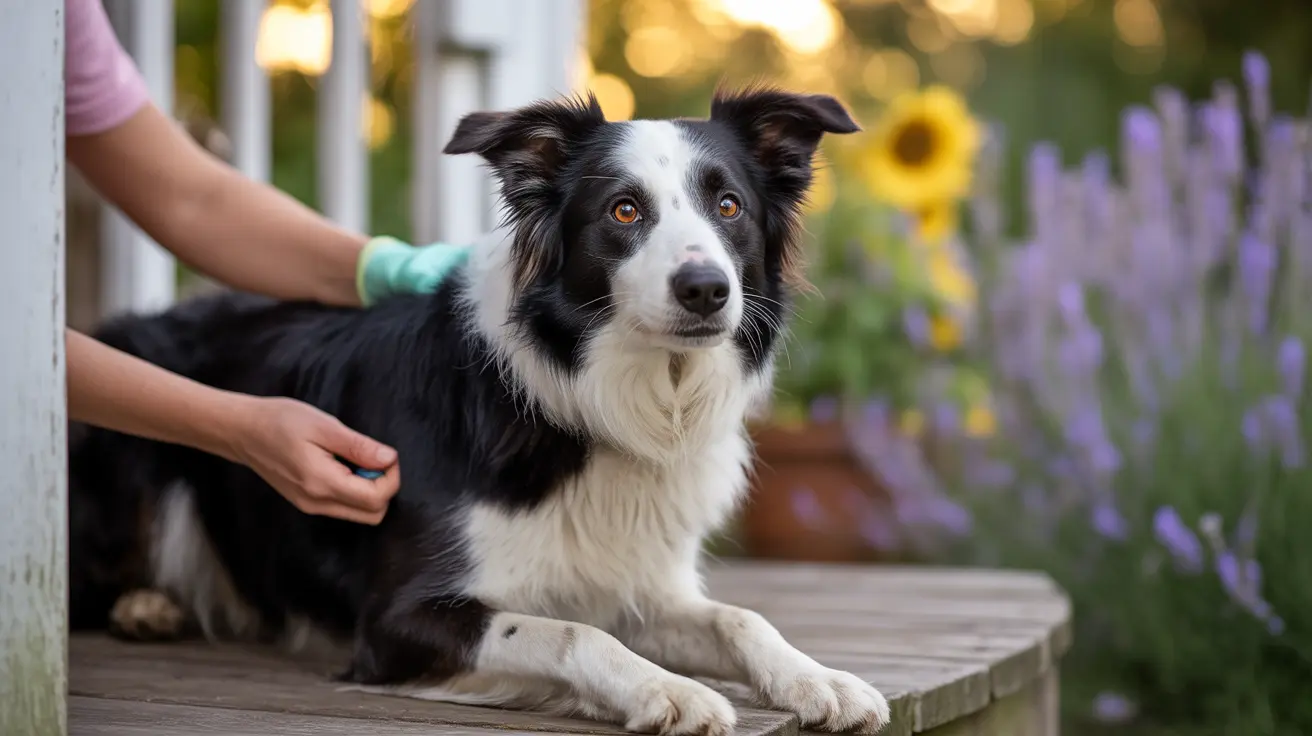When it comes to keeping our furry friends healthy and comfortable, dealing with fleas on dogs ranks among the most critical challenges pet owners face. These tiny parasites are more than just a nuisance—they represent a serious threat to both canine health and household harmony. Understanding how to effectively treat and prevent flea infestations is essential for every dog owner.
Despite their small size, fleas are remarkably resilient creatures that can quickly establish themselves in your home. They feed on your pet's blood, causing intense itching, discomfort, and potentially severe allergic reactions known as flea bite allergies. More concerning still is their ability to transmit various diseases and parasites, making prompt and thorough treatment absolutely essential.
This comprehensive guide will walk you through everything you need to know about identifying, treating, and preventing flea infestations, ensuring your pet stays healthy and comfortable year-round.
How to Check Dogs for Fleas: Early Detection is Key
Recognizing fleas early can make treatment much easier and spare your dog unnecessary discomfort. The first step in flea control is to look for telltale signs on your dog’s skin and coat. Regularly inspect areas like the base of the tail, neck, abdomen, and behind the ears, as fleas often congregate there due to thinner fur and warmer skin. Use a fine-toothed flea comb to help spot adult fleas and flea dirt (tiny black specks that look like pepper).
- Excessive scratching or biting, especially around the tail base and hindquarters
- Small black specks (flea dirt) in your dog's fur
- Visible fleas moving through the coat
- Red, irritated skin or hair loss
- Behavioral changes like restlessness or increased grooming
It's important to differentiate flea problems from other skin issues, as similar symptoms can result from allergies or other parasites. Noticing any of these signs should prompt a closer inspection and, if necessary, a visit to your veterinarian for confirmation and advice.
Effective Dog Flea Treatment Options
Oral Medications
Oral flea treatments are often considered one of the most effective solutions for rapidly eradicating fleas on dogs. These medications work systemically, meaning they circulate throughout your dog’s bloodstream. When fleas bite, they ingest the medication and are quickly killed. Most oral fleа preventatives begin working within hours and are typically administered once a month. They are especially effective for busy households, as they require no drying time and have little risk of washing off with bathing or swimming. Always consult your veterinarian to choose the best product for your dog’s age, weight, and health status.
Topical Solutions
Spot-on treatments are another common choice, directly applied to the dog’s skin, usually between the shoulder blades. These products spread across the skin's oil layer and provide protection for several weeks. They are designed to not only kill adult fleas but may also inhibit egg and larva development, helping break the flea life cycle. Topical solutions are readily available, but it's crucial to follow the application instructions closely and avoid bathing your pet immediately before or after use to maintain effectiveness.
Flea Collars
Flea collars have evolved in recent years and now offer extended, slow-release flea protection for up to eight months. They are generally best used for ongoing prevention and are convenient for pet owners looking to minimize the frequency of reapplication. Modern collars are designed for safety and efficacy, but always check that the product is approved for your dog’s size and age, and ensure the collar sits correctly to avoid irritation or discomfort.
Natural Remedies and Alternative Solutions
For pet owners interested in more natural approaches to flea control, a variety of options may be considered, though results may vary. While they can be useful as part of a broader prevention strategy, natural remedies typically are not as effective for severe infestations and should not be relied upon as your sole form of control.
- Diatomaceous earth: A powder that can be sprinkled on carpets or pet bedding to dehydrate and kill fleas. Only use food-grade diatomaceous earth and avoid inhalation risks.
- Cedar oil: Naturally repellent to fleas and available in sprays or shampoos, but test for sensitivity first.
- Nematodes for yard treatment: Beneficial microscopic worms that prey on flea larvae in soil, reducing future populations outdoors.
- Regular bathing with dog flea shampoo: Frequent washing removes fleas and their eggs, offering immediate relief, but should be done with shampoos formulated for dogs’ skin health.
- Flea spray for dogs made with natural ingredients: Plant-based sprays often contain essential oils like lavender, peppermint, or lemongrass. Always ensure the ingredients are safe for canine use, as some essential oils can be toxic to dogs.
Even when using natural methods, you should monitor your dog for any adverse reactions and consult with your vet to ensure these remedies fit your pet’s overall care plan.
Comprehensive Home Treatment Strategy
Flea control requires a holistic approach, targeting not only your pet but also the environment. Flea eggs, larvae, and pupae often dwell in carpets, bedding, furniture, and even outdoor spaces, making persistent infestations likely if only the dog is treated. Implementing a thorough home cleaning plan is essential to break the flea life cycle and reduce the risk of reinfestation.
- Daily vacuuming: Vacuum carpets, rugs, and upholstery—especially where your pet spends time—to remove fleas and eggs. Empty vacuum bags outdoors to prevent eggs from hatching inside your home.
- Washing bedding: Wash your pet’s bedding (and your own, if the dog sleeps with you) in hot water weekly to kill any remaining fleas or eggs.
- Outdoor treatment: Treat shaded, damp areas of your yard where fleas thrive using safe environmental sprays or nematodes.
- Environmental treatments: Use pet-safe sprays, powders, or foggers for carpets, furniture, and hard-to-reach crevices. Always ventilate rooms and follow manufacturer instructions for safety.
Combining these home treatment strategies with effective pet treatments significantly increases the chance of eradicating fleas and keeping your household pest-free.
Special Considerations for Puppy Flea Control
Puppies are especially sensitive to chemicals and require extra caution when treating for fleas. Many standard flea treatments are not suitable for very young or small puppies. Always:
- Use products specifically labeled for puppies, taking into account age and weight restrictions.
- Consult your veterinarian before beginning any treatment, including so-called natural remedies, to avoid toxicity or adverse reactions.
- Employ manual removal methods, such as using a flea comb, for very young puppies in severe infestations until appropriate medication is safe.
Cleaning the puppy’s bedding and environment is also crucial, as reinfestation is common if the surroundings are left untreated. Ensuring gentle, vet-approved care for puppies helps them grow healthy and flea-free.
Frequently Asked Questions
- How can I tell if my dog has fleas? Common signs include excessive scratching, red skin, flea dirt, and visible fleas. If you suspect fleas, use a flea comb and inspect your dog’s fur—especially around the neck, base of the tail, and belly.
- What is the most effective treatment for dog fleas? Veterinarian-recommended flea medications, such as approved oral or topical products, are most effective and reliable for quickly eliminating infestations and providing ongoing protection.
- Are natural remedies suitable for flea control? Natural remedies can supplement your approach but are usually insufficient alone, especially in severe cases. Always consult your veterinarian before using any alternative treatments to ensure safety and efficacy.
- How often should I treat my dog for fleas? Most treatments are administered monthly, although the exact schedule depends on the product used. Always follow package instructions or your vet’s recommendations to maintain effectiveness.
- What are the risks of untreated flea infestations? Flea infestations can lead to secondary skin infections, severe itching, hair loss, allergic reactions, anemia, and transmission of parasites or diseases such as tapeworms. Untreated cases put both your dog’s health and your home environment at risk.
- Can indoor dogs get fleas? Yes, even indoor pets are at risk. Fleas can hitchhike inside on shoes, clothing, or other pets, so consistent prevention is key regardless of your dog’s lifestyle.
- How do I prevent fleas from returning? Consistent use of flea preventatives, regular cleaning of your home, and periodic yard treatments will help keep fleas at bay. Monitoring your dog for early signs is also crucial.
- Can fleas spread from dogs to humans? Dog fleas rarely live on humans but can bite, causing irritation. Keeping household infestations under control reduces the chances of human discomfort.
- Is it safe to use flea treatments on puppies? Only use treatments specifically formulated and labeled safe for puppies. Always follow age and weight guidelines, and consult your vet for appropriate products if unsure.
- What should I do if my dog has a flea allergy? If your dog is allergic to fleas, work closely with your veterinarian to implement both effective flea control and strategies to manage allergic symptoms. Immediate and aggressive flea elimination may be required, alongside soothing treatments for the skin.
- How long does it take to get rid of a flea infestation? Complete eradication can take several weeks to months, depending on the severity and how thoroughly you manage both the animal and the environment. Persistence in both treatment and cleaning is vital for success.
Successfully controlling and preventing flea infestations requires a comprehensive approach combining proper medication, environmental management, and ongoing prevention. By following these guidelines and maintaining regular flea prevention practices, you can keep your dog comfortable and your home flea-free. Remember to always consult with your veterinarian for personalized advice and treatment recommendations based on your pet's specific needs.






